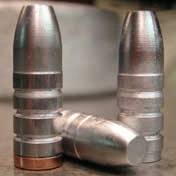

 The Accurate Reloading Forums
The Accurate Reloading Forums  THE ACCURATE RELOADING.COM FORUMS
THE ACCURATE RELOADING.COM FORUMS  Guns, Politics, Gunsmithing & Reloading
Guns, Politics, Gunsmithing & Reloading  Cast Bullets
Cast Bullets  wet lead
wet leadGo  | New  | Find  | Notify  | Tools  | Reply  |  |
| one of us |
I tried casting for the first time last night. I t turned out real well. I cast about 500 rounds of .429. I was dropping the bullets and the sprue into a water bucket. During the course of the evening I found out first hand about water in the lead pot Now my question is: Can I put the lead that I dropped into the water bucket into my pot while the pot is cold, and allow the lead to slowly rise to temperature without causing another lead explosion. Oh yeah, I had let my lead get too hot when I got water in the pot. Did I say | ||
|
| one of us |
quote: | |||
|
| one of us |
Recoiljunky: R: Now my question is: Can I put the lead that I dropped into the water bucket into my pot while the pot is cold, and allow the lead to slowly rise to temperature without causing another lead explosion? F: Yes, this is possible and usually quite safe. Better and safer would be to inspect the bullets, tossing the rejects and all sprues into a bucket and letting them sit for a couple weeks to dry completely. Some folks feel that quenching bullets from the mold is useful and I don't want to get in anyone's way, but, the procedure is not necessary for normal shooting of the typical 44 caliber firearm. In fact, soft bullets work BETTER in revolvers than hard ones do. If at all possible skip the quench step altogether, save time, effort and turn the time to loading/shooting instead. Good evening, Forrest | |||
|
| new member |
Go ahead and put the wet lead in a COLD pot.All the moisture will be driven off by time the lead melts.I do it with wheel weights when making ingots all the time.I have 2 pots I melt in over an old turkey fryer.I fill 1 pot with wet wheel weights,melt them down,remove the clips,flux,then pour ingots.Then I put on the next cold pot fill with more wet weights and do the same thing.As you found out,never put wet anything into a hot pot. Ed | |||
|
| one of us |
quote:I'm letting the lead air dry, I was just worried that moisture could be trapped in voids in the lead. I'll give the non-quenching technique a try for my next batch. Thanks everyone for the info. [ 05-18-2003, 21:30: Message edited by: recoiljunky ] | |||
|
| one of us |
AFTER I SAW THE DAMAGE DONE TO MY BROTHER IN LAW FROM A WATER CAUSED LEAD POT EXPLOSION MY MAIN RULE IS KEEP THE WATER AS FAR AWAY FROM MY MOLTEN LEAD AS POSSIBLE. | |||
|
| one of us |
I imagine you dropped some scrap into the pot after it was wet? The water would need something to take it under the surface to cause a steam explosion. Water drops on top of the melted pot don't cause a blow up. So, you are right, no wet lead back into the pot. | |||
|
| one of us |
One seldom-encountered way of getting water into the lead pot is with large, irregular shaped pieces of potential bullet metal. I once was given a large supply of homemade three pound fishing sinkers. These sinkers were real "raisins", having numerous wrinkles and pits on the surface. The first one that I put in the pot made one popping sound and a small disturbance on the surface of the melt, but no dramatic explosion. All the rest of them got the propane torch treatment before adding to the pot, which caused some hissing as water in the voids was evaporated, but no more strange sounds in the pot. Now I use the torch on large irregular pieces of metal as a standard safety precaution. Another good thing to look out for is moisture sources ABOVE your lead pot. Once I noticed a wet spot in my Coleman stove, about three inches from my lead pot. A gallon jug of windshield cleaner on a high shelf had a small leak. That was a near-miss, now there are no more liquids on that shelf. Hope this helps, curmudgeon | |||
|
| one of us |
The only days I really sweat it are the days I'm making ingots of bullet metal ... as I melt a lot of scrap. Whe I dump stuff into the hot pot, I wear a long shirt, a face shield, and a welding glove on the working hand. If your quenching slugs ... drop the sprue to the side of the quench bucket ... then open the mold over the bucket. I put the sprue cutter plates on a mill and run a ball cutter down the line of ports so I get a pool of excess material that will come off in one piece from gang molds. Save the big pieces of sprue and introduce them carefully to a hot pot, or melt them in the pot starting from cold. [ 06-13-2003, 08:22: Message edited by: mstarling ] | |||
|
| Powered by Social Strata |
| Please Wait. Your request is being processed... |
|

Visit our on-line store for AR Memorabilia

